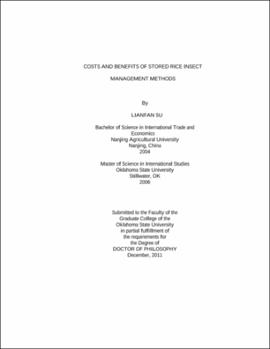| dc.contributor.advisor | Adam, Brian D. | |
| dc.contributor.author | Su, Lianfan | |
| dc.date.accessioned | 2013-11-26T08:22:06Z | |
| dc.date.available | 2013-11-26T08:22:06Z | |
| dc.date.issued | 2011-12 | |
| dc.identifier.uri | https://hdl.handle.net/11244/6541 | |
| dc.description.abstract | Rice quality is important to rice consumers. Insect infestation can significantly reduce the quality, and thus the economic value, of rice. It can also cause quantity losses. Traditional chemical-based pest management uses pesticides to control pests. However the public is increasingly concerned about potential adverse effects of pesticide use on humans and the environment. This challenges rice storage firms to adopt insect control methods which use fewer chemicals, such as integrated pest management (IPM) approaches. | |
| dc.description.abstract | The general objective of this study is to determine optimal insect control methods for rice storage firms. To achieve this objective, costs and benefits of IPM and non-IPM methods are compared. The non-IPM method considered is calendar-based fumigation, and IPM methods considered are controlled aeration and sampling-based fumigation. To measure benefits of each approach, a 2nd -price auction and a choice experiment are conducted to elicit the value consumers place on rice stored using these storage management alternatives and the value they place on more effective insect control. Empirical results of the auction and choice experiment are compared and two potential reasons - anchoring and amount of information provided - are examined to explain possible discrepancies between the two methods. To measure costs of each approach, economic-engineering models are used to calculate expected treatment costs and insect growth models are applied to predict the costs of failing to control insects under the alternative insect control strategies. | |
| dc.description.abstract | Results indicate that even for fairly high insect infestation levels, participants, on average, were not able to distinguish among rice samples that had previously incurred alternative levels of insect infestation. However, after providing them with objective rice quality information, they were willing to pay a premium for rice stored with better insect control (less insect infestation). Also, they preferred rice stored with IPM methods. Participants' willingness to pay (WTP) for use of IPM methods was higher than costs of using IPM methods, estimated using economic engineering methods. Automatically-controlled aeration is less costly than other treatment methods when considering both costs of treatment and costs of failing to control insects. The cost of sampling-based fumigation is higher than calendar-based fumigation at this point. To capture benefits to consumers of adopting IPM methods, rice storage firms may need to contract with an independent agency to verify their storage management practices. | |
| dc.format | application/pdf | |
| dc.language | en_US | |
| dc.rights | Copyright is held by the author who has granted the Oklahoma State University Library the non-exclusive right to share this material in its institutional repository. Contact Digital Library Services at lib-dls@okstate.edu or 405-744-9161 for the permission policy on the use, reproduction or distribution of this material. | |
| dc.title | Costs and benefits of stored rice insect management methods | |
| dc.contributor.committeeMember | Brorsen, B. Wade | |
| dc.contributor.committeeMember | Lusk, Jayson L. | |
| dc.contributor.committeeMember | Currier, Kevin M. | |
| osu.filename | Su_okstate_0664D_11829.pdf | |
| osu.accesstype | Open Access | |
| dc.type.genre | Dissertation | |
| dc.type.material | Text | |
| dc.subject.keywords | auction | |
| dc.subject.keywords | choice experiment | |
| dc.subject.keywords | cost and benefit | |
| dc.subject.keywords | insect infestation | |
| dc.subject.keywords | integrated-pest-management | |
| dc.subject.keywords | stored rice | |
| thesis.degree.discipline | Agricultural Economics | |
| thesis.degree.grantor | Oklahoma State University | |
